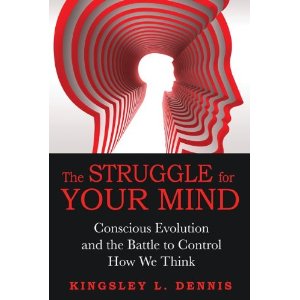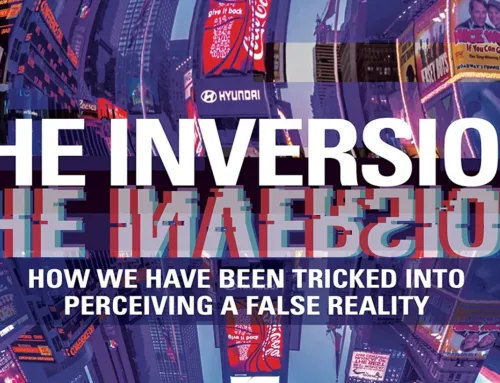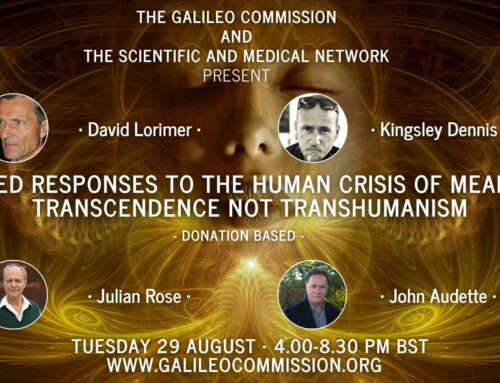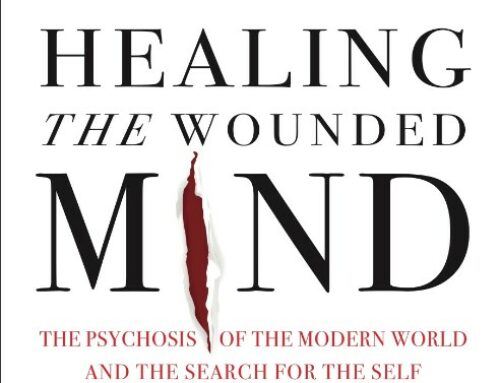Imagination, Cognition and Personality – a review by Nicholas Brink
Struggle for Your Mind – By Kingsley Dennis
May 2013
Over the last several years I have read two books that have intriguing parallels to The Struggle for Your Mind,
Jean Gebser’s Book The Ever-Present Origin
All three books examine the belief that we have been going through a period of time that has restricted in some way our power of consciousness and that we are now entering a new era where our consciousness is opening up into new dimensions. Gebser traces the evolution of our consciousness from the prehistoric eras first of magic, where humans experienced extrasensory power that facilitated their life in hunting and survival.
This era of magic was followed by the era of myth, an era where life was explained through the creation stories and stories of what made things the way they are. We then moved into the third three-dimensional era of rationality that has led us over the last 1500 years in scientific research and methodology. This era has provided us with a rational understanding of life, the earth and the cosmos. Now the fourth era is just opening to us, the era of time-free transparency, an era that provides us with greater understanding of the first two eras, an era where we are breaking free of time as we know it, of where past, present, and future co-exist in the present and where the real power of magic and myths is understood with new and greater transparency.
Tarnas [3] tells us a similar story and is hopeful that we are beginning to rediscover the world soul or the Anima Mundi, an era when we are no longer separated from the world but part of it. With our rational thinking, we have separated ourselves from the world around us, seeing this world as something to research but personally meaningless and random, a world that we abuse and from which we have become alienated. His new world is re-enchanted.
Now, in this book, sociologist Dennis describes our current era of consciousness as one in which we have been lulled asleep by the institutional propaganda and mind control techniques, whether religious, political, or corporate. These institutions have used mind control techniques and fear to distract us from awareness of our deeper feelings and perceptions of ourselves, others, and our environment, preventing us from experiencing life fully and harmoniously. The first six chapters explore how our minds and consciousness have become insidiously and severely restricted by those elite few who seek power and amass wealth. The remaining three chapters describe the ways we are waking up from this sleep to create a healthy and conscious alternative to this restricted life.
Chapter 1, “Governing the Social Mind,” well describes how we are indoctrinated by our personal faith, science, education, and language and how these indoctrinated beliefs are sustained, reinforced, and protected to become the only world we know. What we learn is rarely challenged and we are blind to what lies beyond these narrow confines. The socially valued person adopts these consensual social patterns and behaviors, a powerful pull for social conformity. Propaganda has become a well-researched weapon to engineer public opinion and consolidate social control. As our civilization has become more complex, the engineering of public opinion has become an invisible government for monitoring and suppressing unacceptable forms of thinking. With the increase of urban density during the move from the farms to urban industrial society, the efficient mechanisms for social control have even more hampered the expression of individual creativity.
Engineering public opinion relies on sound bites that include such words as honesty and integrity, though what is said is generally just the opposite, dishonest and with no integrity. Advertising has become sophisticated with the awareness of target audiences, convincing the consumer that the product is needed and indispensable. A person is taught to indulge in self-pleasures that feel good with no concern for what is right or wrong. Distracters are also a central tool in social control, (i.e., providing a choice with one choice being socially unacceptable). This coerced passivity diminishes a person’s responsibility.
Chapter 2, “The Modernity Project,” examines the post-industrial society’s use of technology for analysis, management, and control of people. The techno-mechanized system absorbs and integrates each individual into everything such that the individual is not external to anything but absorbed into the very fabric of the system. The techniques include social-conditioning by school, church, work, and the media, an all-embracing, all inclusive tightly woven social matrix assimilated into a world devoid of magic, mystery, and wonder. Two features of this system, suppression of individual participation and its operation without the need for human intervention, diminish the role of the human being. To this purpose the field of communication in academia was funded by the CIA to assist state and military institutions in the digital age of the database and digital identifiers.
Industrial regiments of work schedules break up the extended family and the individual becomes no more than an industrial unit. Traditional democratic doctrines are obsolete and the state structure is totalitarian. The social matrix technique disseminates misinformation and dis-information as distracters. As people feel an encroaching sense of emptiness, grief, stress, boredom, and anxiety, the entertainment industry and “retail therapy,” (i.e., consumerism, become favorite anesthetics). The financial institutions have control with their credit cards and management of debt. Distracters to our pain include alcohol, weekend blowouts, competitive sports, holidays, even media satire and legal protests. The pharmaceuticals such as antidepressants and Viagra, and the ADHD and ODD medications for children are the biggest profit makers for the industry. The Class-A narcotics such as marijuana that are not conducive to social control but trigger right brain activity are outlawed. A shift to a banal reality in the media, escapism, and living in a fantasy separate us from ourselves and becomes our reality. Again, with this social control we need to start taking back our minds.
Chapter 3, “Living Under Quarantine,” examines global social control. Global social control is growing through such world government agencies as the United Nations, the World Bank, The International Monetary Fund, the European Union, and NATO that are looking towards a New World Order. Reshaping global control is a primary interest of Multinational Corporations with their global control of food, nutrition, healthcare, and pharmaceuticals. With this control, humanity is experiencing a heightening of physical and mental restrictions. People are living within an increasing quarantined environment controlled by central banking and credit card data, tracking travel purchases and healthcare records, DNA collecting, digital databases, chip implants to track objects and people, and surveillance mechanisms such a closed circuit TV (e.g., in the UK there is one surveillance camera for every 12 residents). The issue is how to control an ever growing human population and to manage it in ways that are beneficial to ruling power hierarchies. Except for the Internet, underground and independent news, the majority of us are still living with a managed information embargo. The silent weapons are in the form of computers and sophisticated modeling of societal management that disengage the mind and sabotage mental activity with low quality programming of public education, by engaging emotions and increasing self-indulgence with a constant barrage of sex, violence, and war—junk food for the mind. Rewriting history and law to shift thinking from personal needs to highly fabricated outside priorities is another diversion tactic. One major manipulation is the management of a false and thoroughly artificial economy, with banks creating money by lending it into existence. In the drive for containment, the U.S. Military-Industrial Machine is attempting to construct a total information system of awareness to track and gaze omnisciently over all physical movement and transaction through such technology as surveillance satellites. This global control actively seeks to stifle and marginalize those individuals who seek (without permission) to operate beyond its strictures.
Chapter 4, “Undue Influence,” considers the research on electromagnetic radiation (EM), with the understanding that the background level of radiation is now 100 to 200 million times higher than the normal level of radiation from the sun, an increase caused by power lines, cell phones, and many other electronic sources. Of the several research studies Dennis considers, one was a Russian study of when they beamed EM radiation at the U.S. Embassy in Moscow and later reported that the radiation caused such symptoms as lethargy, lack of concentration, headaches, depression, and impotency. A number of corporations have patented such devices as Sony’s device for transmitting sensory data directly into the human brain to create sensory experiences of taste and sound, or a patented device that can remotely determine a person’s emotional state. In Dennis’s review of such research and patents, he describes a possible future scenario that the thoughts of airline passengers could be scanned remotely for thoughts with dangerous intent. Other research considers the range of brain waves that resonate with the EM waves of the earth and that such waves can influence the human body causing instability in human biorhythms known to cause various diseases including obsessive-compulsive disorders, aggressive behavior, panic attacks, and narcolepsy.
Chapter 5, “Constructions of Fear,” examines fear as the strongest weapon in the attempt to control a person’s consciousness, to weaken harmony and introduce dis-ease. The power of fear has been most evident since 9/11. We are being controlled by “a terrifying peace.” The fear generated by the “War on Terror” has coerced people to spy on their neighbors. Fear has also been used over the centuries by the church in controlling religious beliefs with the fear of the final battle, Armageddon.
Chapter 6, “Winning the War of Minds,” brings us hope. The power of human thought, both positive and creative, has been veiled and dumbed down by the media, corporations, religions, and governmental institutions. We have lost the cognitive skills of our distant ancestors. Everything in Nature spoke to them. The mind extended beyond the human body and connected the human species. To reclaim the power of the mind we must break away from the enslavement of our mind by the few. Dennis believes that we are close to a tipping point in breaking away with signs in how the Internet has been used in anti-government protests such as the Arab Spring and the Occupy Movement. People are beginning to see how our mind has been suppressed and are beginning to take it back. The great awakening is a transformative process that is not individual but applies to our entire species, a shift towards a unified field of awareness, awakening us to the possibilities that there is so much more to our lives than a materialistic and consumer-based lifestyle. This awakening can bring us back to our ability to think intuitively and spiritually. We are in the midst of a global energy shift.
Chapter 7, “Our Evolutionary Futures,” considers future advances in our evolution that will involve developments in our nervous system and consciousness with mutational changes in our DNA. We are on the edge of a possible quantum evolution that will expand our perceptual patterns and open us to other sensory inputs and influences. Latest findings in quantum biology and biophysics indicate that there is a tremendous degree of coherence within all living systems. Each body cell emits biophotons in a resonating field of coherent energy that provides the medium through which the living system communicates. The liquid crystal nature of our DNA is an ideal transmitter of communication, resonance, and coherence. DNA is theorized to be the medium for storage, receiving and communication of information, providing for remote healing, sensing, and telepathy.
A number of writers have suggested that holographic instantaneous communication can occur through this non-local quantum field, communication that is extrasensory. I have reviewed a number of books on this topic for this journal, including Dean Radin [4, 5], two books by Ervin Laszlo [6-9], Rupert Sheldrake [10, 11], and Fritjof Capra [12, 13].
Chapter 8, “Ushering in the New Life,” examines how we are moving into a new energetic epoch where change is inevitable, as the old and new energetic levels clash like waves of quantum interference. Dennis provides a number of stories or myths, because new cultural myths need to be told to support a new model of consciousness. Whereas existing reality has been the world of materialistic consumerism, a world that is external to one’s consciousness, the opposite is the internal world of where our intuition is valued and experienced, where we listen to our DNA. Where the older existing reality relies on conflict between these two worlds, the new model will recognize these two worlds as complements of each other. To attain this balance we must rise above this conflict with an open mind, free from stress, fear, and petty divisive tendencies. The old paradigm holds that present knowledge is superior to the prior knowledge and wisdom of the ancients, a paradigm that takes advantage of and abuses Earth’s resources. The new model values the ecology of our minds as living intelligences with endless connectivity in which we exist in an eco-system of people and Nature with harmony within
our overlapping ecology. Humans generate immense electromagnetic energies in thought and emotions, energy that needs to be directed to positivity, creativity, motivation in order to break from the old paradigm that supports dis-ease and immunity weakness. This energy needs to focus with awareness on our electromagnetic environment, with conscious and careful eating, spending time with ourselves, taking walks in Nature, exercising the physical body, reducing negative thoughts, trusting ourselves to not give into fear, being at ease with emotions, seeking beauty, and avoiding the negative.
Chapter 9, “New Perceptions: Creating Energetic Change in Ourselves,” gives us direction. Buckminster Fuller is quoted in the previous chapter as saying “You never change things by fighting the existing reality. To change, build a new model that makes the existing model obsolete” (p. 192). This chapter gives directions to this new model. Some of its characteristics include being vigilant and aware of the multiple interactions of exterior environment, its forces and influences; being attentive to one’s breathing, listening to what it has to say about one’s personal energy; being attentive to one’s own steps taken within daily life, observing and feeling when one’s actions are correct or when inaction is required; being vigilant to feeling natural and at ease, and taking a few minutes to slow down and create a relaxed space, all to gain better self-understanding. Also important is a vigilance to positive energy and to step away from negative energy. In stepping away you detach one’s self from distraction, noise, and confusion. Conserve positive energy and exercise patience. Step away from the extra baggage of our desires and the polarity game.
References
1. J. Gebser, The ever-present origin, Ohio University Press, Athens, OH, 1985.
2. N. Brink, Book Review: The Ever-Present Origin, by J. Gebser, Imagination, Cognition and Personality, 25
(2), pp. 191-194, 2005.
3. R. Tarnas, Cosmos and Psyche: Intimations of a New World View, Penguin Books, New York, 2007.
4. D. Radin, Entangled Minds: Extrasensory Experiences in a Quantum Reality, Paraview Pocket Books, New
York, 2006.
5. N. Brink, Book Review: Entangled Minds: Extrasensory Experiences in a Quantum Reality, by D. Radin,
Imagination, Cognition and Personality, 30 (2), pp. 237-243, 2010.
6. E. Laszlo, Science and the Akashic Field: An Integral Theory of Everything, Inner Traditions, Rochester, VT,
2007.
7. N. Brink, Book Review: Science and the Akashic Field: An Integral Theory of Everything, by E. Laszlo,
Imagination, Cognition and Personality, 29 (4), pp. 393-397, 2010.
8. E. Laszlo, The Akashic Experience: Science and the Cosmic Memory Field, Inner Traditions, Rochester, VT,
2009.
9. N. Brink, The Akashic Experience: Science and the Cosmic Memory Field, by E. Laszlo, Imagination,
Cognition and Personality, 29 (4), pp. 398-403, 2010.
10. R. Sheldrake, The Presence of the Past: Morphic Resonance and the Habits of Nature, Park Street Press,
Rochester, VT, 1995.
11. N. E. Brink, Book Review: The Presence of the Past: Morphic Resonance and the Habits of Nature, by R.
Sheldrake, Imagination, Cognition and Personality, 28 (3), pp. 295-300, 2009.
12. F. Capra, The Tao of Physics: An Exploration of the Parallels between Modern Physics and Easter
Mysticism, Shambhala Publications, Boston, MA, 2000.
13. N. Brink, Book Review: The Tao of Physics: An Exploration of the Parallels between Modern Physics and
Eastern Mysticism, Imagination, Cognition and Personality, 28 (1), pp. 93-99, 2008.






